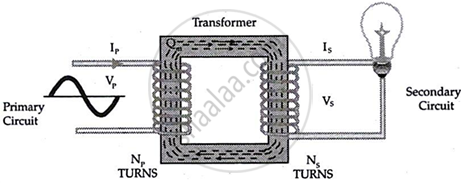Advertisements
Advertisements
प्रश्न
Describe the construction and working of a transformer and hence obtain the relation for `(v_s/v_p)` in terms of the number of turns of primary and secondary.
उत्तर
Transformer: A transformer is a device that increases or decreases an alternating voltage to any specific amount. Step-down transformers are the first type that produces an output voltage equal to the input voltage. Step-up transformers are the second kind that provide an output voltage over the input voltage.
Principle: When the current in a nearby coil varies, an e.m.f. is induced in the secondary coil.
Construction: The figure shows a basic transformer. It consists of two coils with varying turns turned around a closed, laminated soft iron core. Coils are made of insulated wire. The AC input voltage is applied to the primary coil, while the output voltage is measured across the secondary coil.

Working: When an alternating voltage is applied to the primary, an alternating magnetic flux is created that connects to the secondary and forms an electromagnetic field (emf) in it. The value of this emf is based on the number of turns.
When a voltage VP is provided to the core, let Φ represent the flux in each turn caused by the current in the primary at time t.
So, `epsilon_s = -N_s(dphi)/(dt)`
Also, `epsilon_p = -N_p(d phi)/(dt)`
But εp = Vp, and for small current, εs = Vs
⇒ `V_s/V_p = N_s/N_p`
